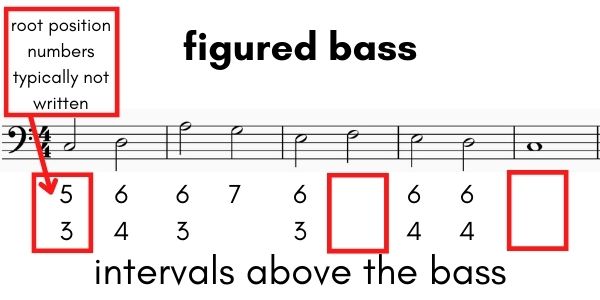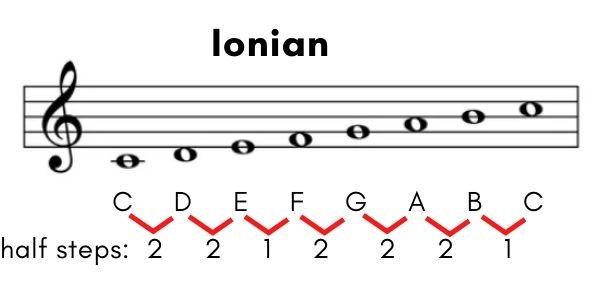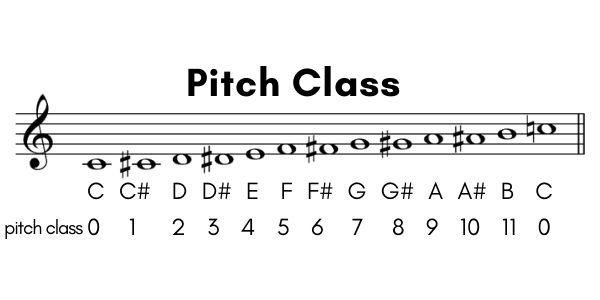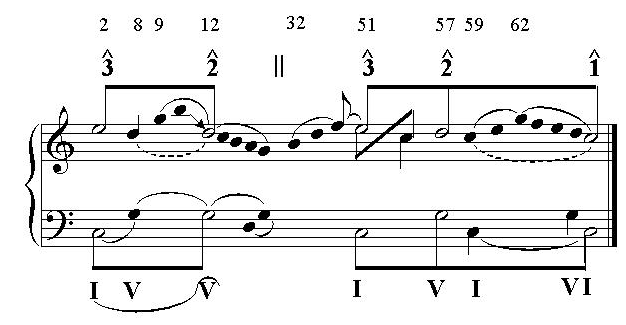This idea that music is math or at least mathematical, is one that I encountered often at the university. To be fair, virtually anything can or does involve numbers and math. But music shares a famous truism with math, they’re both “universal languages”. Whether both deserve that “universal” status could be debated but there must be something to this idea that music and math are bonded in some way, right?
In general, music theory maps well to mathematical concepts. Notable sub-areas of music theory that work particularly well are: set theory, twelve-tone theory, scales, and tunings. Music did not come from math, but numeric notation and mathematic operations work well to describe music.
In this article, I’ll look at some of the ways math and numeric notation have been incorporated into music theory. There are mountains of books written on each of these topics, so please keep in mind I’m just scratching the surface of the surface here.
Numeric notation
In this case, I’m talking about when numbers are used for performance purposes, meaning the music was at least partially written down in a numeric form.
Figured bass music notation
The first example comes from the Baroque era (about 1600) called figured bass or thoroughbass. This system of notation is interesting because it uses both typical staff notation alongside a numeric notation underneath. Figured bass was used for accompaniment parts and was widely practiced up through the classical era. But musicians as late as Arnold Schoenberg noted that he may have been part of the last generation to use figured bass, showing this was a long-lasting form of notation (I learned figured bass in school, but never had to play from it).

Tablature music notation
Tablature style of notation is where numbers represent finger positions but do indicate other performance instructions. For example, tablature does not notate rhythm, articulation, or dynamics. This style of notation was popular for keyboards and lutes starting in the 1400s and is still used today! If you are a guitar player, then you have more than likely played from a tab at one time or another. I learned to play guitar by reading tabs. In many guitar books one will find tabs and standard music notation on the same page.

Musical scales and tuning
Scales and tuning from ancient times until the present all use ratios and proportions to create a series of pitches. The earliest evidence of standardized tunings was transmitted in cuneiform, a writing system from around 3200 B.C. in Mesopotamia and Persia. Surely, by the time the tunings could be written down, some basic measurements and mathematical principles were used by the musicians when creating the tunings. However, most tunings and scales began by humans using their ears, not by calculations – their ears were making calculations that would later be codified by math. Math helped bring an aural tradition to a written notation by being able to more accurately convey scales and tunings across instruments, time, and cultures.
Pythagoras and modes
One of the most well-known stories of math intersecting with music is when Pythagoras was working out ratios of the overtone series on a single string. He was investigating the pitches created when shortening a string. Pythagoras was also a mathematician (the Pythagorean theorem), so math was a core piece of his work. The Greeks codified the musical modes of Western music:
- Ionian
- Dorian
- Phrygian
- Lydian
- Mixolydian
- Aeolian
- Locrian
Each mode is a different permutation of intervals containing seven notes.

Mode permutations of intervals described by number of half steps between each note.
| Mode | Interval Pattern |
| Ionian | 2212221 |
| Dorian | 2122212 |
| Phrygian | 1222122 |
| Lydian | 2221221 |
| Mixolydian | 2212212 |
| Aeolian | 2122122 |
| Locrian | 1221222 |
Tunings and scales both came about through different paths depending on the culture devising the systems. Many musical cultures may not be able to describe their systems in mathematical terms because that is not at all how they think of them. Perhaps precise tunings and intervals are not necessary pieces of the music, but rather performing the intent of the music is all that is required.
Twelve-tone equal temperament tuning
The Western tuning system eventually landed on twelve-tone equal temperament. Zhu Zaiyu, a Chinese mathematician and music theorist developed the system around 1580 CE. If you look at a guitar you will count twelve frets that go from the open string to the octave. Moving from one fret to the next are equal half steps. Math was imperative to precisely achieve this tuning. Here is the equation:
![{\displaystyle {\sqrt[{12}]{2}}=2^{\frac {1}{12}}\approx 1.059463}](https://wikimedia.org/api/rest_v1/media/math/render/svg/232c2beab28b1c46c328080d982595d9ef196e08)
Many have experimented with tunings and scales throughout musical history. Some used their ears, and some relied more on math. Harry Partch, the 20th century American composers, created many microtonal scales. His most used scale is the 43-tone scale. Without going too far down the microtonal rabbit hole, Partch wanted to explore sounds that were foreign to Western ears. He based his scale on the 11th limit – the 11th partial in the overtone series. He believed this was the natural next step for music.
Analysis and composition
Finally, let’s look at how math has been used in analysis and composition.
Set theory
Set theory assigns each pitch a number. From there mathematical operations can be performed. With this theory you can easily analyze intervallic relationship and transformations that happen across the piece that may have been obscured by standard music notation.

Here is an example of transposition using pitch class notation:
A C major chord in pitch class notation is 047. Let’s say we want to transpose it up by four half steps. Just add 4 to each of the pitches:
- 0+4 = 4,
- 4+4 = 8,
- 7+4 = 11(E)
Our new chord is 48E or EG#B an E major triad.
Set theory enables analysis of both tonal and nontonal music. It can also handle scales that are in different modulos. The diatonic system is in “mod 12”. This means you count 1, 2, 3, 4, 5, 6, 7, 8, 9, 10, 11, 1, 2… But you can also have mod 5 (1, 2, 3, 4, 1, 2…).
Set theory in music is obviously heavily mathematical. In my undergraduate days, I took a math and music class that was taught by Jack Douthett, a PhD Mathematician. As a composer, set theory and mathematical operators can be used as a basis for compositions or ways to generate material – moving from explanatory theory to being an engine for creation.
Twelve-tone analysis
Twelve-tone music is usually analyzed by using set theory but with one additional condition, ordered sets. In twelve-tone music there is the prime “row” which is a fixed order of the twelve equal tempered notes.

Once the prime row has been identified one can determine how subsequent rows have been transformed. Common transformations (operators) in twelve-tone music are:
- transposition
- retrograde
- reflection
- complementation
- multiplication
- permutation
All those operators maintain specific relationships with the prime row. From the example above the following chart can be created that shows many of these transformations. It’s called a 12-tone matrix.
| I-4 | I-7 | I-6 | I-3 | I-9 | I-T | I-2 | I-0 | I-8 | I-5 | I-1 | I-E | ||
| P-4 | 4 | 7 | 6 | 3 | 9 | T | 2 | 0 | 8 | 5 | 1 | E | R-4 |
| P-1 | 1 | 4 | 3 | 0 | 6 | 7 | E | 9 | 5 | 2 | T | 7 | R-1 |
| P-2 | 2 | 5 | 4 | 1 | 7 | 8 | 0 | T | 6 | 3 | E | 8 | R-2 |
| P-5 | 5 | 8 | 7 | 4 | T | E | 3 | 1 | 9 | 6 | 2 | 0 | R-5 |
| P-E | E | 2 | 1 | T | 4 | 5 | 9 | 7 | 3 | 0 | 8 | 6 | R-E |
| P-T | T | 1 | 0 | 9 | 3 | 4 | 8 | 6 | 2 | E | 7 | 5 | R-T |
| P-6 | 6 | 9 | 8 | 5 | E | 0 | 4 | 2 | T | 7 | 3 | 1 | R-6 |
| P-8 | 8 | E | T | 7 | 1 | 2 | 6 | 4 | 0 | 9 | 5 | 3 | R-8 |
| P-0 | 0 | 3 | 2 | E | 5 | 6 | T | 8 | 4 | 1 | 9 | 7 | R-0 |
| P-3 | 3 | 6 | 5 | 2 | 8 | 9 | 1 | E | 7 | 4 | 0 | 9 | R-3 |
| P-7 | 7 | T | 9 | 6 | 0 | 1 | 5 | 3 | E | 8 | 4 | 2 | R-7 |
| P-9 | 9 | 0 | E | 8 | 2 | 3 | 7 | 5 | 1 | T | 6 | 4 | R-9 |
| RI-4 | RI-7 | RI-6 | RI-3 | RI-9 | RI-T | RI-2 | RI-0 | RI-8 | RI-5 | RI-1 | RI-E |
There’s a lot to explain about this matrix, but I’ll leave it here for now. If you are curious, I recommend the following books.
Here is an example of some twelve-tone music by one of my favorite composers in this style, Anton Webern.
At this point, some may ask if music is math or art? Music is an art that can be described by using numbers and mathematical operators. Do you need math in order to create music? Absolutely not! Even when composers use numbers and mathematics to generate ideas and form pieces, including the extreme serialism of Milton Babbitt, it is a work of art. There is intent of expression beyond the notes on a page.
Roman numeral analysis
Roman numeral analysis is one of the basic foundations of an education in music theory. This analysis opens a way to see the relationships of harmony. By ascribing chords a number, theorists can more easily examine key elements of the music such as form, phrasing, cadences, and function. This type of analysis is designed for tonal music. Using it on pre-tonal or post-tonal music has very limited application.
Some important ideas to know about this type of analysis is that you must be working with a piece of music that has a key. You will also have to know the names of the notes of the scale being used. The notes of the scale are called scale degrees and each scale degree corresponds to a name. Roman numerals come in capital letters for major quality triads and lower-case letters for minor quality triads.
| Scale Degree | Name | Roman Numeral |
| 1 | Tonic | I/i |
| 2 | Supertonic | II/ii |
| 3 | Mediant | III/iii |
| 4 | Subdominant | IV/iv |
| 5 | Dominant | V/v |
| 6 | Submediant | VI/vi |
| 7 | Leading tone | VII/vii |
Roman numeral analysis is combined with a kind of figured base notation to indicate the intervals up from the bass note. This shows more detail and helps cut through what might be obscured by the notes on the page. I won’t go into what all the notation means but the fact that we are using numerals to better analyze and describe the music is the point.

One of the most powerful insights that can come from this analysis is understanding the function of the harmony in relation to the entire piece. In tonal music there is a hierarchy of importance: tonic is the most important, dominant is next most important, etc… Heinrich Schenker, (1868–1935), took this concept to its extreme by breaking down large scale works to their most principal relationships – that of the tonic and dominant. Here is what one of his analyses may look like. The example is an analysis of 62 measures. As you can see it is highly condensed and the roman numerals and numbers above show the major structures of the music. The numbers above indicate the scale degree decent from 3 to 1.

Like I said in the beginning of this article, I’m only scratching the surface of the surface. There are countless books on this topic, and I certainly won’t do it justice here. If you are interested in learning more about this kind of analysis, I recommend these books or this course.
AI compositions
Lastly, I wanted to include music that comes exclusively from numbers – compositions by artificial intelligence. The very “nature” in which these compositions are achieved are by ones and zeros. Even though the programs were trained and taught patterns in music, they create new and novel pieces. In my opinion this is the deepest level of numbers and music that is currently happening. Here is a video exploring a few pieces composed by AI and humans side by side.
Math and rhythm?
The extent of my knowledge on this topic is limited to compositional explorations. For example, exploring time signatures (expressed as fractions – hello math!), polyrhythms, and metric modulation. Unfortunately, I do not know any of the “theory” behind these techniques, so I did not discuss them above. I did not include math and rhythm because I’m unfamiliar with rhythmic theory. I know there has been a lot of work in this area but I need to read up on it. So forgive me for excluding this important part of music, it is due to ignorance not interest.

Leave a Reply